Optimizing Parallel EVM from Reddio
An overview of the parallel EVM implementation ideas of Ethereum's second-layer Reddio.
 JinseFinance
JinseFinance
Author: Xinwei, MT Capital
The necessity of parallel EVM is that it solves The efficiency of traditional EVM processing transactions in sequence significantly improves the throughput and performance of the network by allowing multiple operations to be executed simultaneously.
The implementation methods of parallel EVM include scheduling-based concurrent processing, multi-threaded EVM instances, system-level sharding, and face challenges such as unreliable timestamps, blockchain determinism and Technical challenges such as verifier income orientation.
Monad Labs, through its Layer 1 project Monad, aims to significantly improve the scalability and transaction speed of the blockchain through unique technical features, including processing up to 10,000 per second transactions, 1 second block time, parallel execution capabilities and MonadBFT consensus mechanism.
Sei V2 is an important upgrade of the Sei network, aiming to become the first fully parallelized EVM, providing backward compatibility with EVM smart contracts, optimistic parallelization, and new SeiDB data Structure and interoperability with existing chains, designed to significantly increase transaction processing speed and network scalability.
Neon EVM is a platform on Solana that aims to provide an efficient, secure, and decentralized environment for Ethereum dApps, allowing developers to easily deploy and run dApps, while Take advantage of Solana’s high throughput and low cost.
Lumio is a Layer 2 solution developed by Pontem Network that innovatively solves Ethereum’s scalability challenges by uniquely supporting EVM and Move VM used by Aptos , improving the Web3 experience to close to the Web2 level.
Eclipse is an Ethereum Layer 2 solution that uses SVM to accelerate transaction processing, adopts a modular rollup architecture, and integrates Ethereum settlement, SVM smart contracts, Celestia data availability and RISC Zero fraud proof.
Solana utilizes its Sealevel technology to implement parallel smart contract processing, Sui improves throughput through Narwhal and Bullshark components, Fuel implements parallel transaction execution through the UTXO model, and Aptos uses Block-STM Engine to improve transaction processing capabilities, all demonstrate the different implementations and advantages of parallel technology in the blockchain field.
Key challenges in adopting parallelism include resolving data races and read-write conflicts, ensuring technology compatibility with existing standards, adapting to new ecosystem interaction patterns, and managing system complexity Increases, especially in terms of security and resource allocation.
Parallel EVM demonstrates great potential in enhancing blockchain scalability and efficiency, marking a major shift in blockchain technology through simultaneous execution on multiple processors Transactions are used to improve transaction processing capabilities and break through the limitations of traditional sequential transaction processing. While parallel EVMs offer tremendous potential, their successful implementation requires overcoming complex technical challenges and ensuring broad ecosystem adoption.
The Ethereum Virtual Machine (EVM) is the core of the Ethereum blockchain The core component that serves as its computing engine. It is a quasi-Turing complete machine that provides a running environment for smart contract execution on the Ethereum network, which is critical for maintaining trust and consistency throughout the Ethereum ecosystem.
The EVM executes smart contracts by processing bytecode, which is a more basic form of compiling smart contract code typically written in a high-level programming language such as Solidity. These bytecodes consist of a series of operation codes (opcodes) used to perform various functions, including arithmetic operations and data storage/retrieval. The EVM runs as a stack machine, processing operations in a last-in-first-out manner. Each operation in the EVM has an associated gas cost. This gas system measures the computational effort required to perform operations, ensuring fair resource allocation and preventing network abuse.
In Ethereum, transactions play an important role in the functionality of the EVM. There are two types of transactions: those that cause a message to be called, and those that cause a contract to be created. Contract creation results in the creation of a new contract account containing the compiled smart contract bytecode, and when another account makes a message call to the contract, its bytecode is executed.
The architecture of EVM includes components such as bytecode, stack, memory and storage. It has a dedicated memory space for temporary storage of data during execution, and a persistent storage space on the blockchain for holding data indefinitely. The design of the EVM ensures a secure execution environment for smart contracts, isolating them to prevent reentrancy attacks, and employing various security measures such as gas and stack depth limits.
In addition, the influence of EVM goes beyond Ethereum and extends to a wider range through the EVM compatible chain. These chains, while different, maintain compatibility with Ethereum-based applications, allowing them to interact seamlessly with Ethereum-based applications. These chains play a key role in various fields such as enterprise solutions, GameFi, and DeFi.
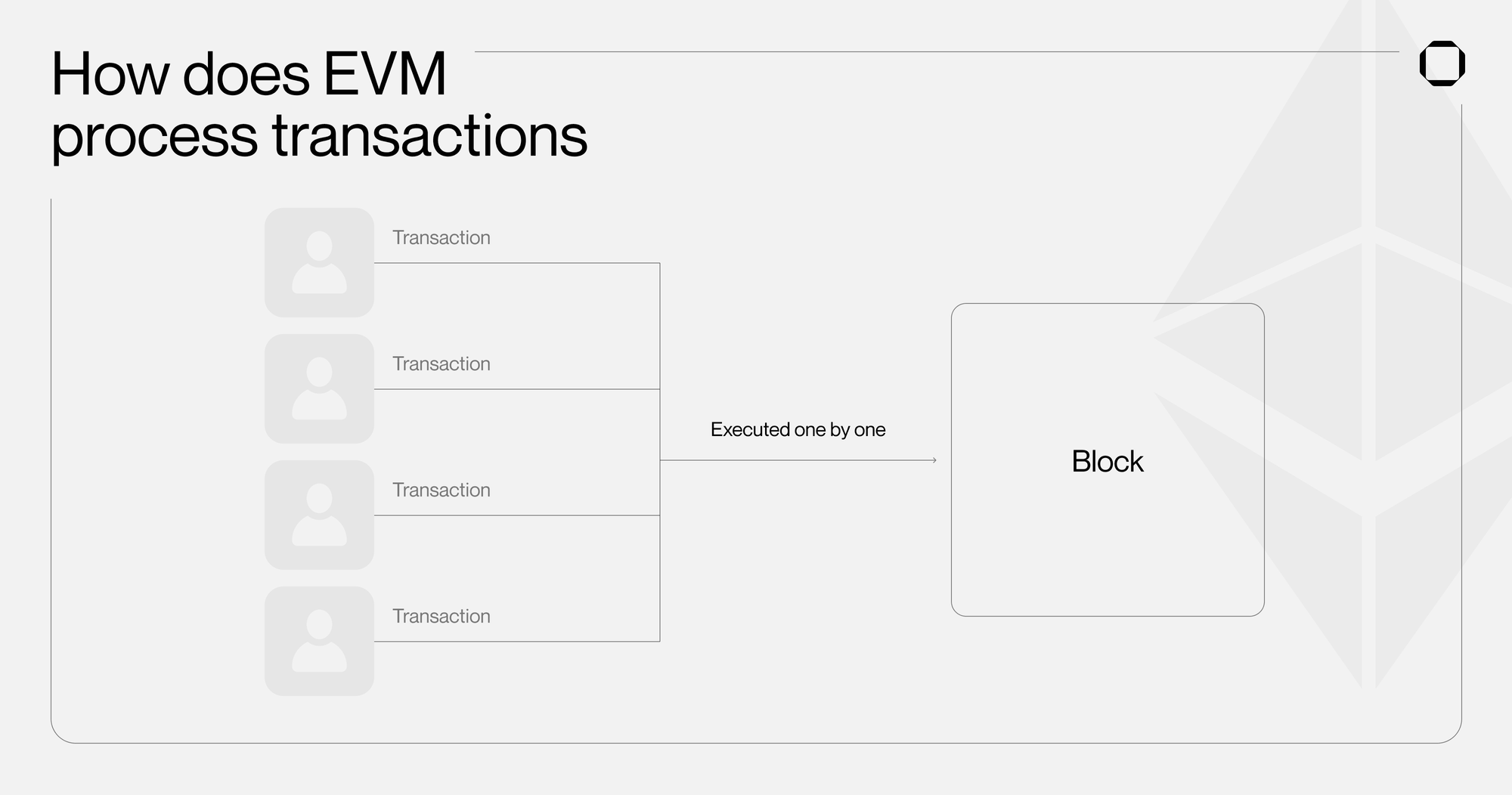
The necessity of parallel EVM (Ethereum Virtual Machine) stems from its ability to significantly improve the performance and efficiency of the blockchain network. Traditional EVM processes transactions sequentially, which not only consumes a lot of energy, but also places a heavy workload on network validators. This approach often results in high transaction costs and inefficiencies, and is considered a major obstacle to widespread blockchain adoption.
Parallel EVM revolutionizes the consensus process by allowing multiple operations to be executed simultaneously. The ability to execute in parallel greatly increases the throughput of the network, thereby enhancing the performance and scalability of the entire blockchain. Using parallel EVM, the blockchain network can process more transactions in a shorter time, effectively solving the common congestion problems and slow processing times of traditional blockchain systems.
Parallel EVM has a significant impact on all aspects of blockchain technology:
It provides a more Energy-efficient transaction processing method. By offloading the work of validators and the entire network, parallel EVM helps build a more sustainable blockchain ecosystem.
Improved scalability and increased throughput directly lead to lower transaction fees. Users will enjoy a more economical experience, making blockchain platforms more attractive to a wider audience.
Processing multiple transactions simultaneously rather than sequentially means dApps can run more smoothly even during periods of high network demand.
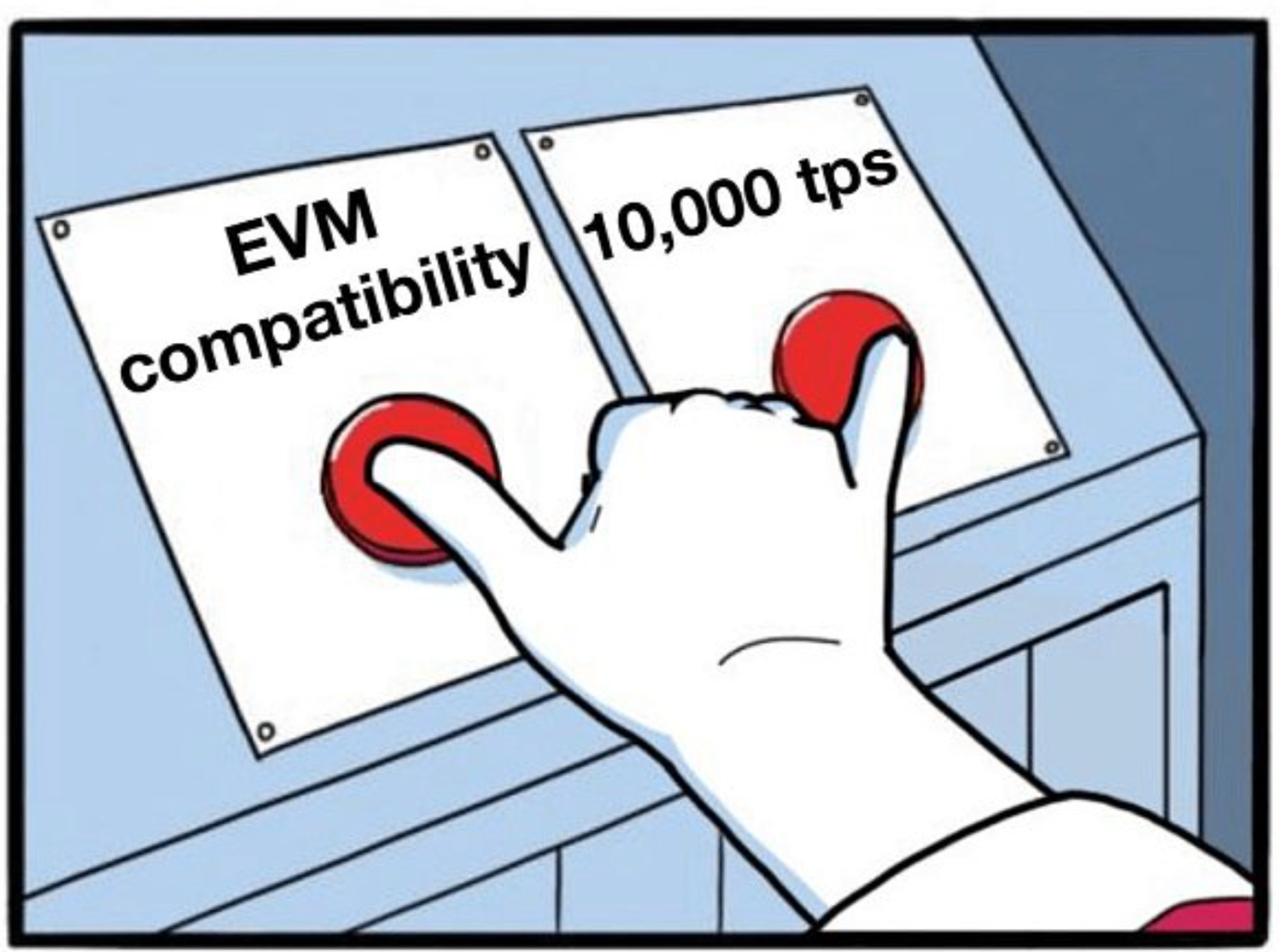
In the current EVM architecture, the most sophisticated read and write operations are sload and sstore, which are used to read and write data from the state trie respectively. Therefore, ensuring that different threads do not conflict on these two operations is an easy entry point to implement parallel/concurrent EVM. In fact, there is a special type of transaction in Ethereum that includes a special structure called an "access list" that allows transactions to carry storage addresses that are to be read and modified. Therefore, this provides a good starting point for implementing a scheduling-based concurrency approach.
In terms of system implementation, there are three common forms of parallel/concurrent EVM:
Multiple threads of one EVM instance .
Multiple threads for multiple EVM instances on one node.
Multi-threading of multiple EVM instances on multiple nodes (basically system-level sharding).
The difference between parallelism/concurrency in blockchain and database systems is:
Unreliable timestamps make timestamp-based concurrency methods difficult to deploy in the blockchain world.
Absolute certainty on the blockchain system to ensure that transactions re-executed between different validators are the same.
The ultimate goal of validators is higher returns, not faster execution of transactions.
So what do we need?
System-level consensus is required, and faster execution will bring higher returns.
Multivariable scheduling algorithms that take block constraints into account can capture more revenue while completing execution faster.
More fine-grained data operations, including opcode-level data locking, memory cache layer, etc.
Monad is EVM Layer 1, designed to Significantly improve blockchain scalability and transaction speed. The key advantage of Monad is that it can handle up to 10,000 transactions per second and has a block time of 1 second. This is due to its MonadBFT consensus mechanism and EVM compatibility, which enable it to process transactions efficiently and quickly.
One of the most striking features of Monad is its parallel execution capabilities, which allows it to process multiple transactions simultaneously, which is a huge improvement compared to the sequential processing methods in traditional blockchain systems. Network efficiency and throughput.
Monad development is led by Monad Labs, co-founded by Keone Hon, Eunice Giarta and James Hunsaker. The project has successfully raised $19 million in seed funding and plans to launch a testnet in the middle of the first quarter of 2024, followed by a mainnet launch.
Monad has been optimized in the following four main areas to make it a high-performance blockchain:
MonadBFT:
MonadBFT is a high-performance consensus mechanism for the Monad blockchain, used to achieve consistency in transaction ordering under partial synchronization conditions in the presence of Byzantine actors. . It is an improved version based on HotStuff, using a two-stage BFT algorithm with optimistic responsiveness and linear communication overhead in common situations and quadratic communication overhead in timeout situations. In MonadBFT, the leader sends a new block and the QC (Quorum Certificate) or TC (Timeout Certificate) of the previous round to the validator in each round. The validator reviews the block and, if agreed, sends a signed "yes" vote to the next round of leaders. This process aggregates the "yes" votes of **2f+1** validators through threshold signatures to form QC. In the common case of communication, the leader sends blocks to the validators, who directly send votes to the leader for the next round. MonadBFT also adopts pairing-based BLS signatures to solve scalability issues. It can incrementally aggregate signatures into a single signature, and verifying a single valid aggregate signature can prove that the shares associated with the public key have signed the message. For performance reasons, MonadBFT adopts a hybrid signature scheme, where BLS signatures are only used for aggregable message types (voting and timeouts). Message integrity and authenticity are still provided by ECDSA signatures. Due to these characteristics, MonadBFT is able to achieve efficient and robust blockchain consensus.
Delayed execution:
This is a key innovation that decouples the execution process from the consensus process. Under this architecture, the consensus process involves nodes agreeing on an official ordering of transactions, while execution is the process of actually executing those transactions and updating the state. In this design, the leader node proposes the transaction ordering, but does not know the final state root when proposing the ordering; the validator node does not know whether all transactions in the block will execute successfully when voting on the validity of the block.
This design allows Monad to achieve significant speed improvements, allowing single-shard blockchains to scale to millions of users. In Monad, each node independently executes the transactions in block N while reaching consensus on block N, and starts to reach consensus on block N+1. This approach allows for a larger gas budget since execution only has to keep up with consensus. Additionally, this approach is more tolerant to specific variations in computation time since execution only has to keep up with consensus on average.
To further ensure state machine replication, the Monad includes a Merkle root delayed by D blocks in the block proposal. This delayed Merkle root ensures that consistency across the network is maintained even if a node performs erroneous or malicious behavior.
In MonadBFT, finality is single slot (1 second), and execution results typically lag less than 1 second on full nodes. This single-slot finality means that after a transaction is submitted, users will see the official ordering of transactions a single block later. Unless a supermajority of the network acts maliciously, there is no possibility of reordering. For users who need to understand trading results quickly (e.g., high-frequency traders), a full node can be run to minimize latency.
Parallel execution:
It enables Monad to execute multiple transactions simultaneously. This approach may appear to be different from Ethereum's execution semantics at first glance, but it is not. Monad's blocks are the same as Ethereum's blocks, which are linearly ordered collections of transactions. The results of executing these transactions are the same between Monad and Ethereum.
During parallel execution, Monad uses an optimistic execution method, which starts executing subsequent transactions before earlier transactions in the block are completed. This can sometimes lead to incorrect execution results. Monads solve this problem by tracking the inputs used in executing a transaction and comparing them to the outputs of previous transactions. If there is a discrepancy, the transaction needs to be re-executed with the correct data.
In addition, Monad uses a static code analyzer to predict dependencies between transactions when executing transactions to avoid ineffective parallel execution. In the best case, a Monad can predict many dependencies ahead of time; in the worst case, it falls back to a simple execution mode.
Monad’s parallel execution technology not only improves network efficiency and throughput, but also reduces transaction failures caused by parallel execution by optimizing execution strategies.
MonadDb:
MonadDb is used for optimization of data storage and processing. It is part of a Monad optimization strategy aimed at improving overall network performance, especially when it comes to processing state data and transaction data. Such components are designed to enhance the efficiency and scalability of data storage and improve the blockchain network's ability to handle large amounts of data. It includes improved data indexing mechanisms, more efficient storage structures and optimized data access paths. These optimizations help reduce data access time and increase transaction processing speed, thereby improving the performance of the entire blockchain network.
Tayaswap
TayaSwap is a Monad-based AMM DEX developed by SubLabs Providing support, it allows assets to be traded without traditional order books or intermediaries. AMM relies on mathematical formulas and smart contracts to facilitate token exchanges, determine prices, and utilize smart contracts to enable peer-to-peer transactions.
Ambient Finance
Ambient (formerly CrocSwap) is a decentralized trading protocol that allows the combination of centralized and Bilateral AMM with constant product liquidity. Ambient runs the entire DEX in a single smart contract, where a single AMM pool is a lightweight data structure instead of separate smart contracts.
Shrimp Protocol
Shrimp is a (3,3) DEX with flywheel token economics, supports real-world assets, and is coming to Monad soon .
Catalyst
Catalyst is a permissionless liquidity solution between modular blockchains, purpose-built to connect all chains , designed to enable access to any asset from anywhere. Catalyst enables developers to automatically connect to all chains and gain access to users in a unified ecosystem, while its simple, decentralized and self-hosted design ensures projects can access liquidity securely and seamlessly.
Swaap
Swaap is a market-neutral automated market maker (AMM). It combines oracles and dynamic spreads to provide sustainable earnings for liquidity providers and cheaper prices for traders. The protocol significantly reduces impermanent losses and provides multi-asset pools.
Elixir
Elixir is a decentralized market-making protocol that uses market-making algorithms to interact with centralized exchanges through API calls. Tail crypto assets bring liquidity.
Timeswap
Timeswap is an AMM-based decentralized money market protocol that does not use oracles or liquidators. Unlike Uniswap, where assets can be traded in real time, borrowing on Timeswap involves trading tokens until repayment is complete. The lender provides Asset A for borrowing money while "protecting" a certain amount of Asset B that the borrower uses as collateral. Users can adjust their risk profile to obtain higher interest rates with lower mortgage ratios, or vice versa.
Poply
Poply is a community-based NFT market dedicated to the Monad chain, displaying and empowering NFT collections created specifically for this chain. By using AI-generated art and a user-friendly interface, it attracts people interested in unique NFTs to trade ERC-721 tokens here.
Switchboard
Switchboard is a permissionless, customizable, multi-chain oracle protocol for universal data feeds and verifiable randomness. By allowing anyone to push any form of data, regardless of data type, it provides a one-stop shop for users and helps drive the next generation of decentralized applications.
Pyth Network
Pyth Network is a next-generation price oracle solution developed by Douro Labs, aiming to provide projects and protocols as well as the public with blockchain technology. Provides valuable financial market data on the chain, including cryptocurrencies, stocks, foreign exchange, commodities, etc. The network aggregates first-party price data from more than 70 trusted data providers and publishes it for use by smart contracts and other on-chain or off-chain applications.
AIT Protocol
AIT Protocol is an artificial intelligence data infrastructure that provides Web3 artificial intelligence solutions. The AIT decentralized marketplace offers millions of cryptocurrency users a unique and extensive opportunity to participate in "train to earn money" tasks, a concept that simultaneously enables them to earn rewards while actively contributing to the development of artificial intelligence models and contribute to development.
Notifi
Notifi provides a common communication layer for all Web3 projects, and plans to embed notification and messaging capabilities into decentralized applications to facilitate digital transformation. and interact with users through on-chain channels. Notifi API allows developers to unlock complex communication infrastructure through simple APIs that can provide native user experiences for all applications in the world; Notifi Center provides users with a notification experience of customized information, which will be available from mobile and web Allowing users to view and manage all information in the Web3 world; Notifi Push enables marketers to create cohesive, multi-channel engagements that drive business growth and retain their user base.
ACryptoS
ACryptoS is an advanced crypto strategy platform, a multi-chain yield aggregation optimizer and DEX, providing automatic compounding of single-token vaults , dual-token LP vault, unique liquidity vault, Balancer-V2 branch DEX and stable currency exchange, and a variety of unique products. Initially launched on the BNB chain in November 2020, ACryptoS has expanded to 11 chains with over 100 vaults deployed, aiming to support DeFi users and protocols.
MagmaDAO
MagmaDAO is a liquidity staking protocol controlled by DAO, aiming to achieve fair token distribution through ecosystem competitive airdrops. It is an Ethereum The first distributed validator outside the blockchain, built on the fastest, cheapest, and most censorship-resistant EVM L1 Monad.
Wombat Exchange
Wombat Exchange is a multi-chain stablecoin exchange with an open liquidity pool, low slippage and one-sided staking.
Wormhole
Wormhole is a decentralized universal messaging protocol that enables developers and users of cross-chain applications to leverage multiple ecosystems System advantages.
DeMask Finance
DeMask Finance is an on-chain AMM protocol for transactions between NFTs and ERC20 tokens. DeMask Finance supports the creation of NFT collections and NFT launch pads: paired with ETH and other tokens. NFT decentralized exchange: Supports pairing of ERC-1155 NFTs or other tokens with ETH and ERC-20 tokens. Designed to add liquidity to the NFT market, the DeMask protocol provides an interface to enable seamless exchange between ERC20 tokens or native tokens and NFT collections. DeMask is a system of interconnected smart contracts that allows all users to create and own liquidity pools and trade in a fully automated manner. Each pool will hold a pair of assets, including a token and an NFT, providing a fixed price for instant trading. This also allows other contracts to estimate the average price of the two assets over time. Users with liquidity pools will be rewarded when exchanging asset pairs.
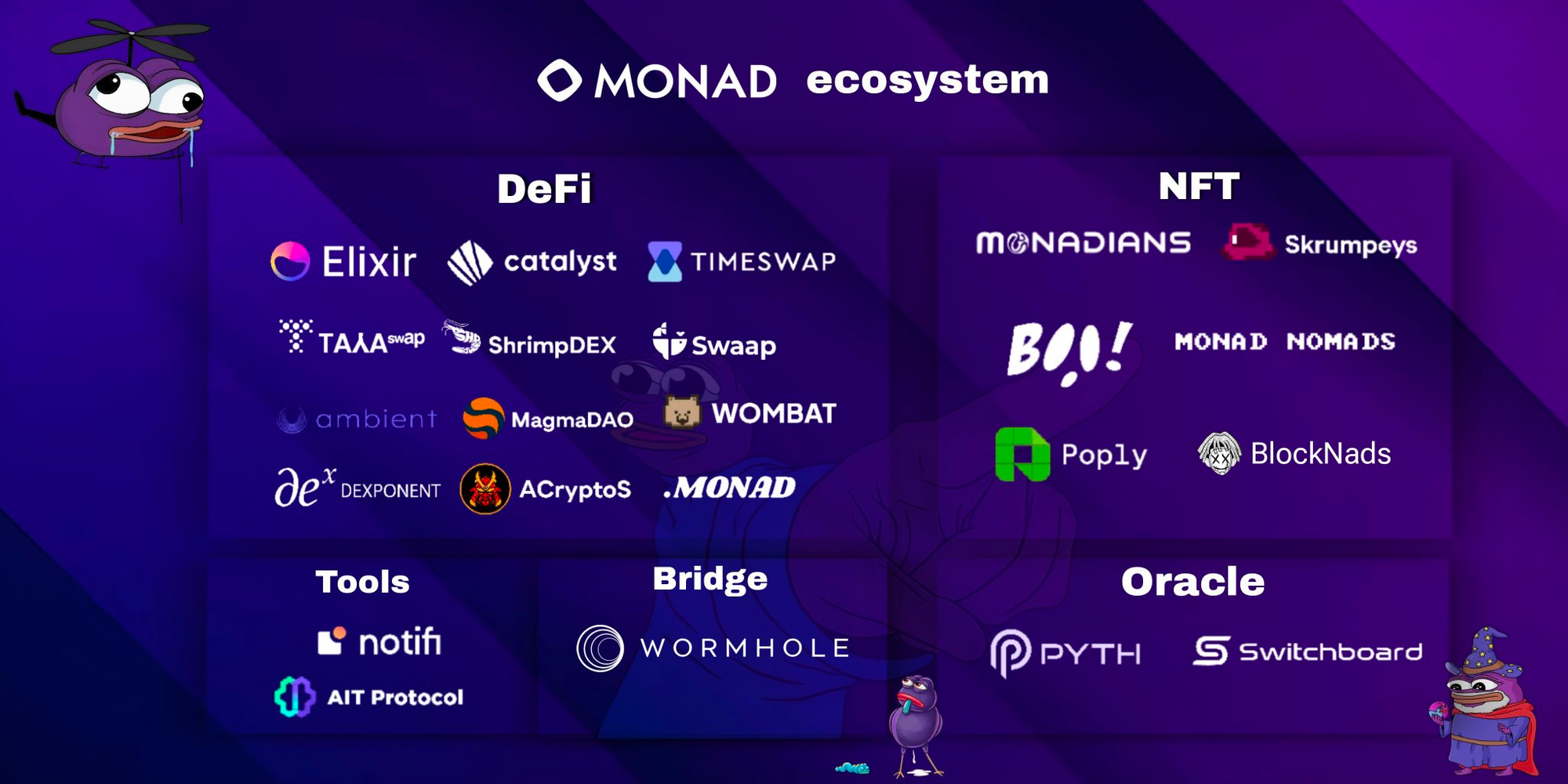
Sei V2 is an important upgrade to the Sei network and aims to be the first fully parallelized EVM. This upgrade will enable Sei to have the following features:
Backwards compatible with EVM smart contracts:
< p>This means that developers can deploy audited, EVM-compatible smart contracts on Sei without changing their code. This is extremely important for developers as it simplifies the process of transferring their existing smart contracts from other blockchains such as Ethereum to Sei.From a technical perspective, Sei nodes will automatically import Geth, the Go implementation of the Ethereum Virtual Machine. Geth will be used to process Ethereum transactions, and any resulting updates (including state updates or calls to non-EVM related contracts) will be made through a special interface created by Sei for the EVM.
Optimistic parallelism:
It allows the blockchain to support without requiring developers to define any dependencies Parallelization. This means that all transactions can run in parallel, and when a conflict occurs (for example, a transaction touches the same state), the chain will keep track of the portion of storage touched by each transaction and re-run those transactions in order. This process will continue recursively until all unexplained conflicts are resolved. Because transactions are ordered in blocks, the process is deterministic, simplifying developer workflow while maintaining chain-level parallelism.
SeiDB:
It will introduce a new data structure called SeiDB to optimize the platform's storage layer. The main goal of SeiDB is to prevent state bloat, the problem where the network becomes too data-heavy, while simplifying the state synchronization process for new nodes. Such a design aims to improve the overall performance and scalability of the Sei blockchain.
Sei V2 achieves this goal by transforming the traditional IAVL tree into a two-component system - state storage and state commitment. This change significantly reduces latency and disk usage, and Sei V2 also plans to move to using PebbleDB to improve read and write performance for multi-threaded access.
Interoperability with existing chains:
Sei V2 allows EVM to be integrated with any other execution environment supported by Sei The seamless combination of blockchain and blockchain provides a smoother experience for developers, who can easily access native tokens and other chain features such as staking. It will also create a new component to support EVM smart contracts. These EVM smart contracts will benefit from all changes made to consensus and parallelization, and will also be able to interact with existing Cosmwasm smart contracts.
From a performance perspective, Sei V2 will provide a throughput of 28,300 batch transactions per second, while providing a block time of 390 milliseconds and a finality of 390 milliseconds. . This enables Sei to support more users and provide a better interactive experience than existing blockchains, while providing cheaper per-transaction costs.
The main upgrade progress of Sei V2 is currently close to code completion. After the review is completed, this upgrade will be released in the public testnet in the first quarter of 2024 and will be deployed to the mainnet in the first half of 2024.
Neon EVM leverages the capabilities of the Solana blockchain to provide an efficient environment for Ethereum dApps. It runs as a smart contract within Solana, allowing developers to deploy Ethereum dApps with minimal or no code changes and benefit from Solana’s advanced features. The Neon EVM's architecture and operations focus on security, decentralization, and sustainability, providing Ethereum developers with an opportunity to seamlessly transition to the Solana environment. It leverages Solana’s low fees and high transaction speeds with its ability to enable transactions to execute in parallel, provide high throughput and reduce costs. The main components of the Neon EVM ecosystem include:
Neon EVM Program:
It is an EVM compiled into Berkeley Packet Filter bytecode and runs on Solana. It processes Ethereum-like transactions (Neon transactions) on Solana, following Ethereum rules. Neon EVM is configured through a decentralized multi-signature EVM account, and participants can change the Neon EVM code and setting parameters.
The process of Neon EVM processing transactions involves several key steps. First, users initiate an Ethereum-like transaction (N-tx) through an Ethereum-compatible wallet. These transactions are encapsulated into Solana transactions (S-tx) through Neon Proxy and then passed to the Neon EVM program hosted on Solana. The Neon EVM program unblocks transactions, verifies user signatures, loads EVM status (including account data and smart contract code), executes transactions in the Solana BPF (Berkeley Packet Filter) environment, and updates Solana's status to reflect the new Neon EVM status.
Neon Proxy: It enables Ethereum dApps to be ported to Neon with minimal reconfiguration. Neon Proxy packages EVM transactions into Solana transactions and provides them as a containerized solution for ease of use. Operators running Neon Proxy servers facilitate the execution of Ethereum-like transactions on Solana, accepting NEON tokens for gas fees and other payments within the Solana ecosystem.
Neon DAO: The DAO provides custody services for the Neon Foundation and guides future research and development. It operates as a series of contracts on Solana, providing a governance layer that controls the functionality of the Neon EVM. NEON token holders can participate in DAO activities, including proposing and voting on proposals.
NEON Token: This utility token has two main functions - paying gas fees and participating in governance through the DAO.
Integrations and Tools: Neon EVM supports a variety of integrations and tools for development and analysis. These include block explorers like NeonScan, ERC-20 SPL wrappers for token transfers, NeonPass for transferring ERC-20 tokens between Solana and Neon EVMs, NeonFaucet for testing tokens, and compatibility with EVMs like MetaMask Wallet compatibility.
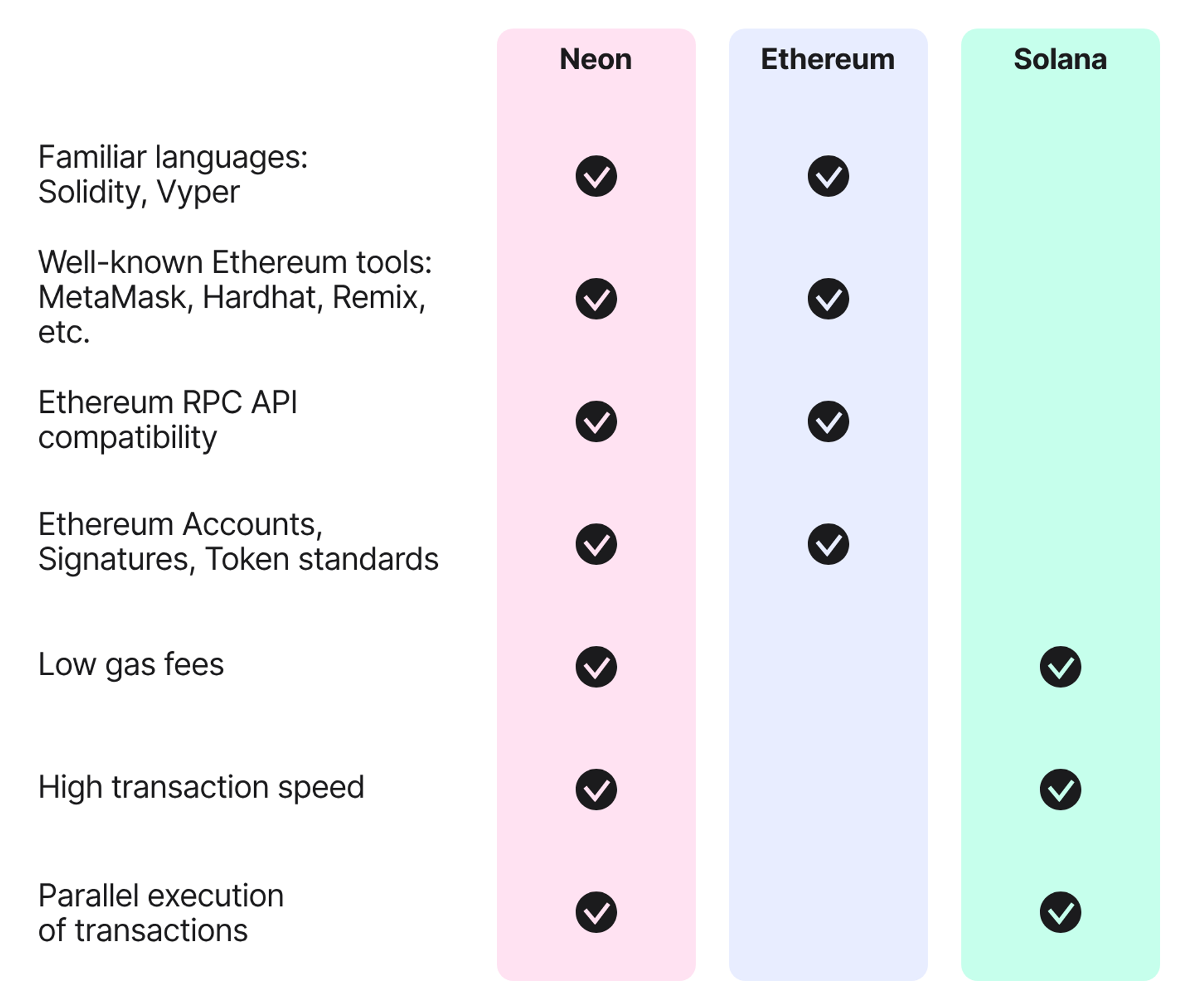
Eclipse is a Layer 2 solution for Ethereum that greatly accelerates transaction processing by leveraging the Solana Virtual Machine (SVM). Eclipse is designed for speed and scalability, using a modular rollup architecture and integrating key technologies such as Ethereum settlement, SVM smart contracts, Celestia data availability, and RISC Zero security.
Specifically, Eclipse Mainnet combines the best of modular stack parts:
Settlement layer -Ethereum: Eclipse uses Ethereum as its settlement layer. At this layer, transactions are finalized and secured. Using Ethereum not only means taking advantage of its robust security and liquidity, but also using ETH as the gas token to pay for transaction fees. This setup allows Eclipse to inherit strong security features from Ethereum.
Execution layer -SVM: In terms of smart contract execution, Eclipse uses SVM. This is in stark contrast to the way EVM executes transactions sequentially, SVM is capable of parallel transaction processing. Its Sealevel runtime features transactions that do not involve overlapping states and can be processed in parallel, allowing Eclipse to scale horizontally and improve throughput.
Data availability -Celestia: To ensure that data is timely available and verifiable, Eclipse uses Celestia. Celestia provides a scalable and secure platform for data publishing and is an important support for Eclipse's high throughput.
Fraud Proof - RISC Zero: Eclipse integrates RISC Zero to perform zero-knowledge fraud proof, avoiding the need for intermediate state serialization, thereby improving improve the efficiency and security of the system.
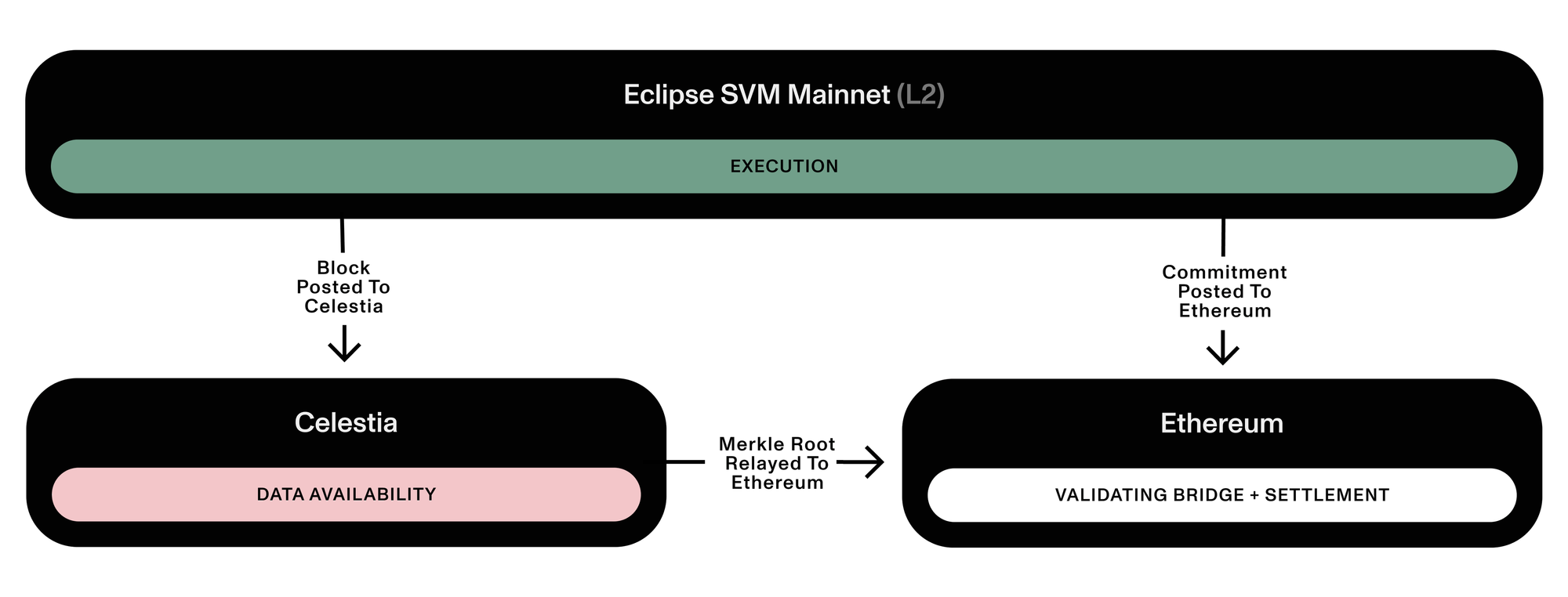
The design goal of Eclipse is to provide a universal Layer 2 solution for Ethereum that can be used on a truly large scale. It is designed to address the limitations caused by specific application rollups and the resulting isolation and complexity issues that can lead to a worsened user and developer experience. Eclipse offers an attractive option for building scalable and performant dApps on Ethereum through its modular rollup system and integrated technology components.
Lumio is a Layer 2 solution developed by Pontem Network to solve the scalability challenges of Ethereum and bring a Web2-like experience to Web3. It stands out as a unique rollup in the blockchain space due to its ability to support both EVM and Move VM used by Aptos. This dual compatibility allows Lumio to process transactions on Aptos while simultaneously settling on Ethereum, providing a versatile and efficient solution for dApp developers and users. It has the following key features:
Dual virtual machine compatibility: Lumio uniquely supports EVM and Aptos Move VM. This dual compatibility enables Lumio to seamlessly integrate the functionality of Ethereum and Aptos, increasing flexibility and efficiency in dApp development and execution.
High throughput and low latency: By leveraging high-performance chains like Aptos for transaction ordering, Lumio significantly increases transaction bandwidth. This integration ensures that Lumio can efficiently handle large volumes of transactions while maintaining Ethereum’s security and liquidity characteristics.
Optimistic Rollup Technology: Lumio uses the open source OP stack and adopts optimistic rollup technology. Optimistic rollups are known for their efficient transaction processing and lower costs, making them suitable for scaling Ethereum-based applications.
Flexible Gas cost economic model: Lumio introduces an application-centric Gas cost economic model. This model allows application developers to directly benefit from network usage, potentially inspiring more innovative and user-friendly dApp development.
Interoperability and integration: Lumio is able to process transactions on Aptos and settle on Ethereum, demonstrating different blockchain ecosystems High degree of interoperability between systems. This feature enables developers to take full advantage of Ethereum and Aptos in their applications.
Balance of security and scalability: Combining the strong security of Ethereum and the scalability of Aptos, it provides developers with An attractive solution to build high-performance, secure dApps. Lumio's architecture is designed to effectively balance these two key aspects.
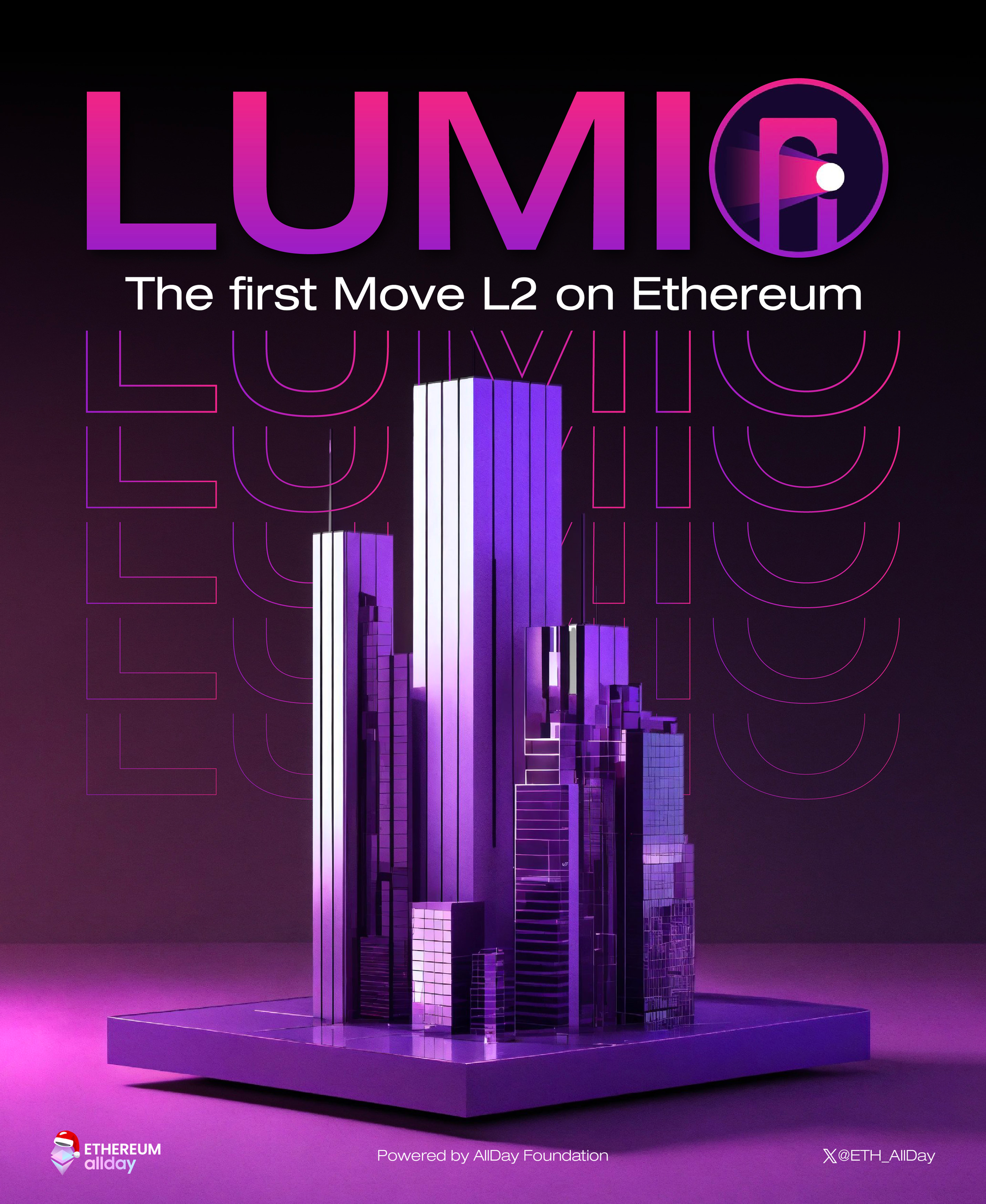
Lumio is currently in a closed beta phase and plans to gradually roll it out to selected users. This approach allows for thorough testing and improvements to the platform based on user feedback, ensuring a robust and user-friendly platform upon wider release.
Solana’s Sealevel technology is a key component of its blockchain architecture and aims to enhance intelligence through parallel processing technology Contract performance. This approach is significantly different from the single-threaded processing of other blockchain platforms, such as EVM and EOS’s WASM-based runtime, which process one contract at a time and modify the blockchain state sequentially.
Sealevel enables the Solana runtime to process tens of thousands of contracts in parallel, utilizing all cores available to the validator. This parallel processing capability is possible because Solana transactions explicitly describe all states that will be read or written during execution, allowing non-overlapping transactions to execute concurrently, as well as transactions that only read the same state.
Sealevel’s core functions are based on Solana’s unique architecture, including components such as the Cloudbreak account database and the Proof of History (PoH) consensus mechanism. Cloudbreak maps public keys to accounts, accounts maintain balances and data, and programs (stateless code) manage state transitions for these accounts.
Transactions in Solana specify a vector of instructions. Each instruction contains the program, the program instructions, and the list of accounts the transaction wishes to read and write. This interface, inspired by low-level operating system interfaces to devices, allows the SVM to sort millions of pending transactions and schedule all non-overlapping transactions for parallel processing. Additionally, Sealevel can sort all instructions by program ID and run the same program on all accounts simultaneously, a process similar to the SIMD (Single Instruction Multiple Data) optimization used in GPUs.
Solana’s Sealevel provides multiple benefits, including enhanced scalability, reduced latency, cost efficiency, and improved security. It enables the Solana network to handle a significantly higher number of transactions per second, provides near-instant transaction finalization, and reduces transaction fees. Even during parallel processing, smart contract security is maintained through Solana’s strong security protocols.
Sealevel makes Solana a powerful decentralized application platform by enabling high-speed parallel processing and increased transaction throughput.
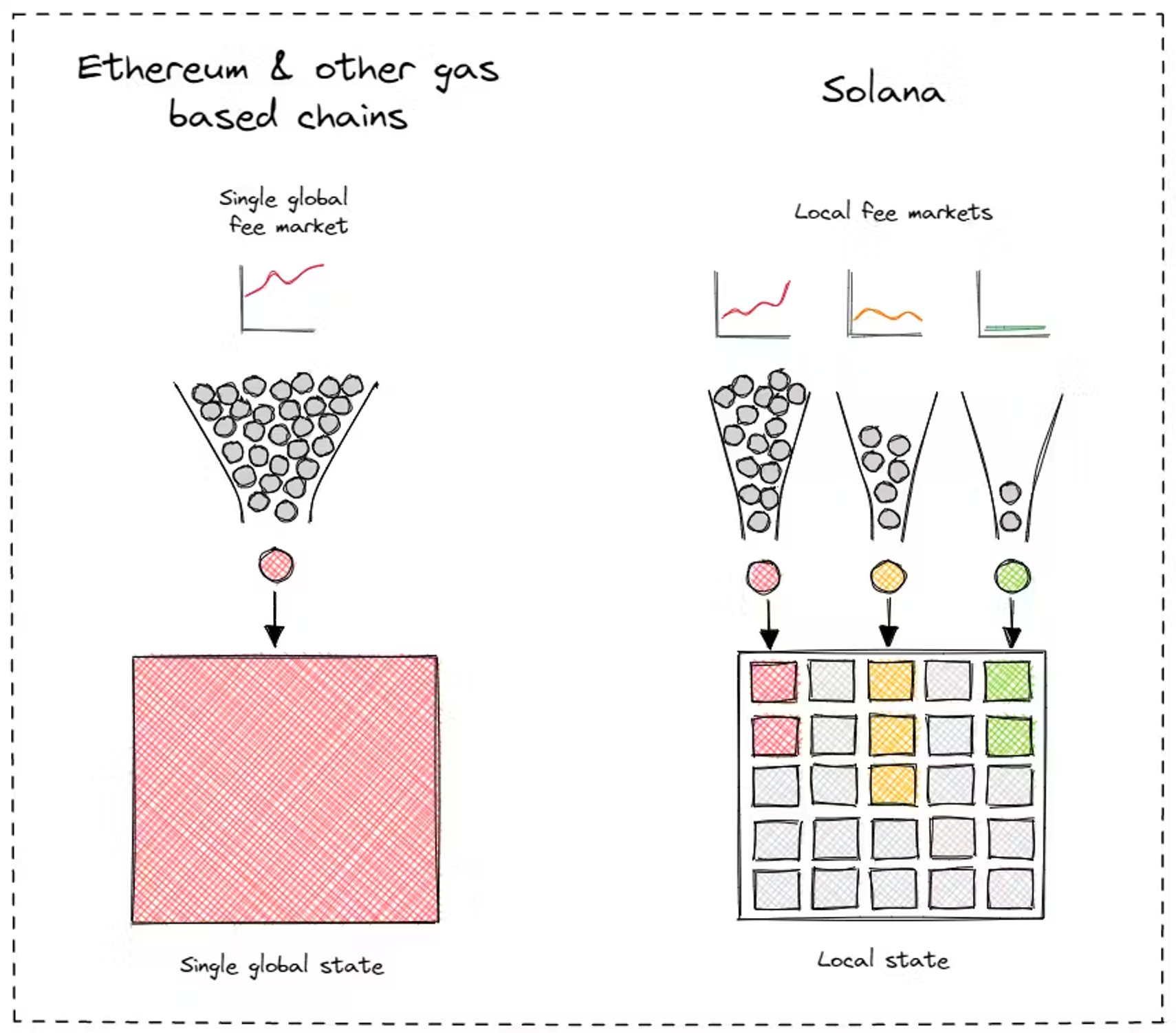
Sui’s parallel technology features make it a highly efficient, high-throughput blockchain platform suitable for a variety of Web3 applications and use cases. These salient features work together to improve the efficiency and throughput of its network:
Narwhal and Bullshark components : These two components are crucial to Sui’s consensus mechanism. Narwhal serves as a memory pool, responsible for accelerating transaction processing, improving network efficiency, and ensuring the availability of data when submitted to Bullshark (consensus engine). Bullshark is responsible for sorting the data provided by Narwhal, utilizing a Byzantine fault tolerance mechanism to verify the validity of transactions and distribute these transactions across the network.
Asset ownership model: In the Sui network, assets can be owned by a single owner or shared by multiple owners. Assets from a single owner can be quickly and freely transferred across the network, while shared assets need to be verified through a consensus system. This asset ownership system not only improves the efficiency of transaction processing, but also enables developers to create multiple types of assets for their applications.
Distributed Computing: Sui's design allows the network to scale resources based on demand, making it function like a cloud service. This means that as demand for the Sui network increases, network validators are able to add more processing power, maintain network stability, and keep gas fees low.
Sui Move Programming Language: Sui Move is Sui’s native programming language, designed for creating high-performance, secure, and feature-rich applications . It is based on the Move language and aims to improve the defects in the smart contract programming language, improve the security of smart contracts and the work efficiency of programmers.
Programmable Transaction Block (PTB): PTB in Sui is a complex, composable transaction sequence that can be accessed in all smart contracts Any public on-chain Move function. This design provides strong guarantees for payment or finance-oriented applications.
Horizontal scalability: Sui’s scalability is not limited to transaction processing, but also includes storage. This enables developers to define complex assets with rich properties and store them directly on-chain without having to use indirect off-chain storage to save gas fees.
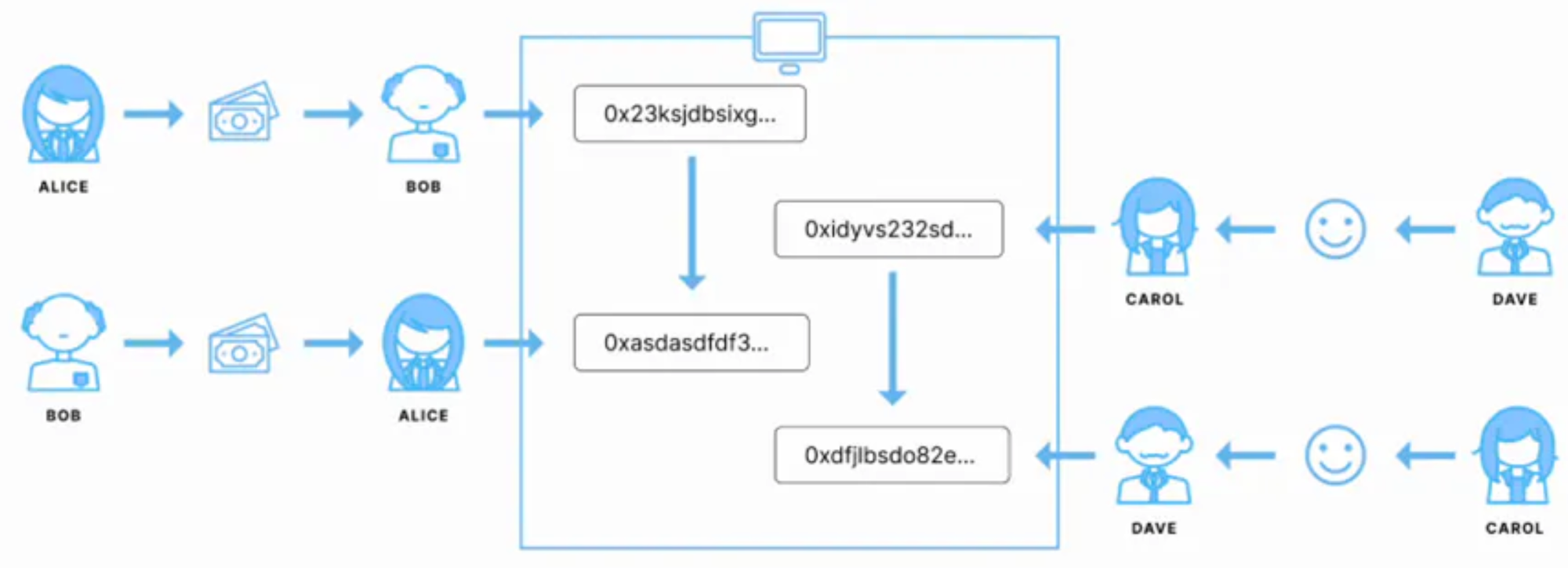
In the Fuel network, "parallel transaction execution" is a key technology that enables the network to efficiently process a large number of transactions. The core of this parallel execution is achieved through the use of strict state access lists based on the UTXO (Unspent Transaction Output) model. This model is a fundamental element in Bitcoin and many other cryptocurrencies.
Fuel introduces the capability of parallel transaction execution in the UTXO model. By using strict state access lists, Fuel is able to process transactions in parallel, thereby utilizing more CPU threads and cores that would normally be idle in single-threaded blockchains. In this way, Fuel can provide more computing power, state access and transaction throughput than single-threaded blockchains.
Fuel solves the concurrency problem in the UTXO model. In Fuel, instead of signing UTXOs directly, users sign the contract ID, indicating their intention to interact with the contract. Therefore, users do not directly change the state, causing UTXO to be consumed. Instead, the block producer will be responsible for handling how the various transactions in the block affect the overall state and thus the contract UTXO. A consumed contract UTXO creates a new UTXO with the same core characteristics but updated storage and balance.
In order to achieve parallel transaction execution, Fuel developed a specific virtual machine-FuelVM. The design focus of FuelVM is to reduce wasteful processing in traditional blockchain virtual machine architecture, while providing developers with more potential design space. It incorporates years of lessons learned from the Ethereum ecosystem and suggestions for improvements that could not be implemented on Ethereum due to the need to maintain compatibility with past versions.
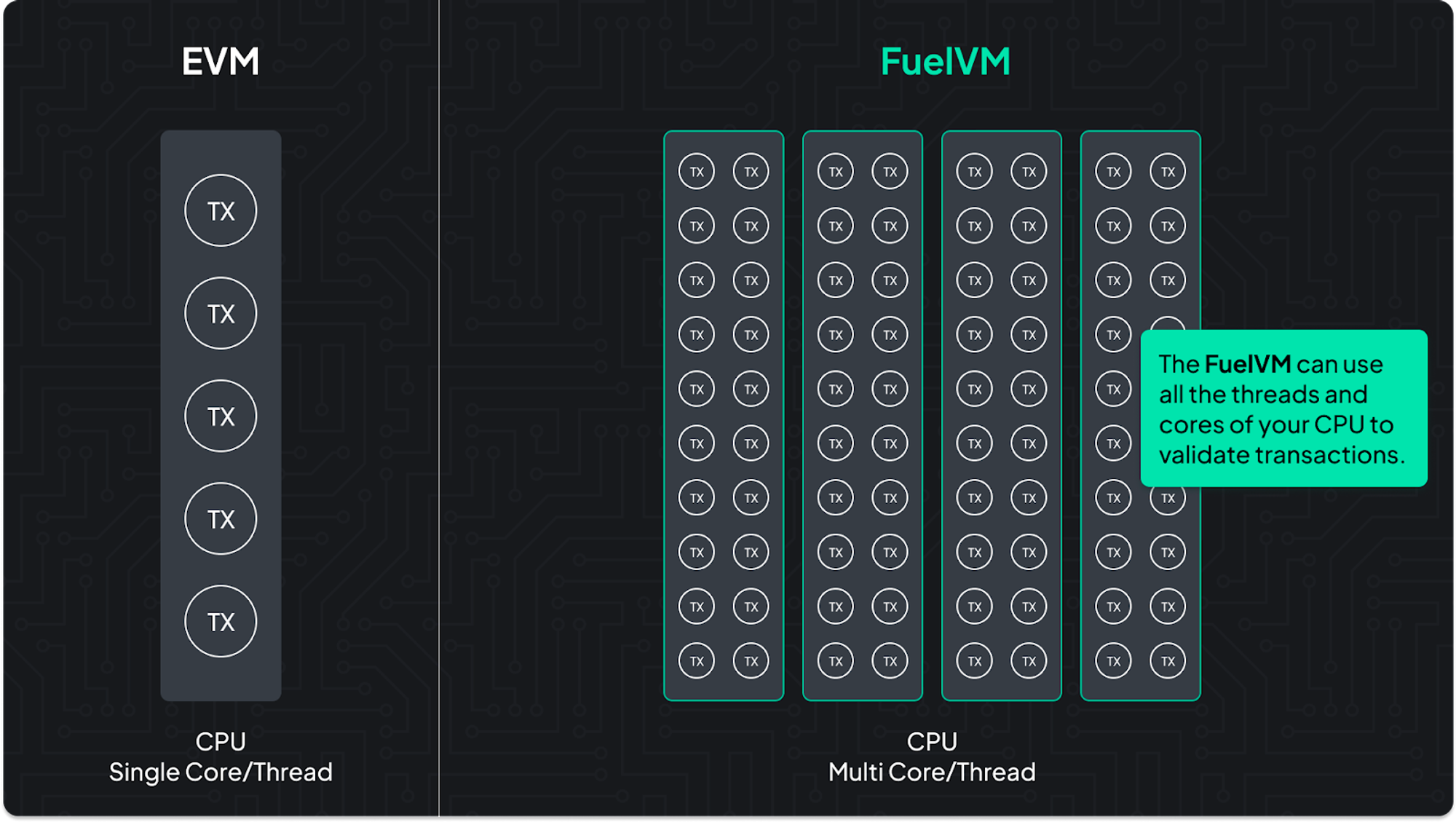
The Aptos blockchain uses a parallel execution engine called Block-STM (Software Transaction Memory) to enhance its ability to process transactions. This technology allows Aptos to execute transactions in a preset order in each block, assigning transactions to different processor threads during execution. The core idea of this method is to record the memory locations modified by the transactions while executing all transactions. After all transaction results have been verified, if a transaction is found to have accessed a memory location modified by a previous transaction, the transaction will be invalidated. The aborted transactions are then re-executed and the process repeats until all transactions have been executed.
Unlike other parallel execution engines, Block-STM maintains the atomicity of transactions without the need to know in advance the data to be read/written. This makes it easier for developers to build highly parallelized applications. Block-STM supports richer atomicity than other parallel execution environments, which often require operations to be split into multiple transactions (breaking logical atomicity). Block-STM enhances user experience by reducing latency and improving cost efficiency.
In addition, Aptos also adopts a consensus mechanism called AptosBFTv4, a production blockchain BFT protocol with strict correctness proof. The protocol optimizes responsiveness, provides low latency and high throughput, and takes full advantage of the underlying network. AptosBFTv4 adopts a processor-like pipeline design to ensure maximum utilization of resources at every step. Therefore, a single node may participate in many aspects of consensus, from selecting transactions for inclusion in a block to executing another set of transactions, writing the outputs of another set of transactions to storage, and certifying the outputs of another set of transactions. This makes the throughput limited only by the slowest stage, rather than the sequential combination of all stages.
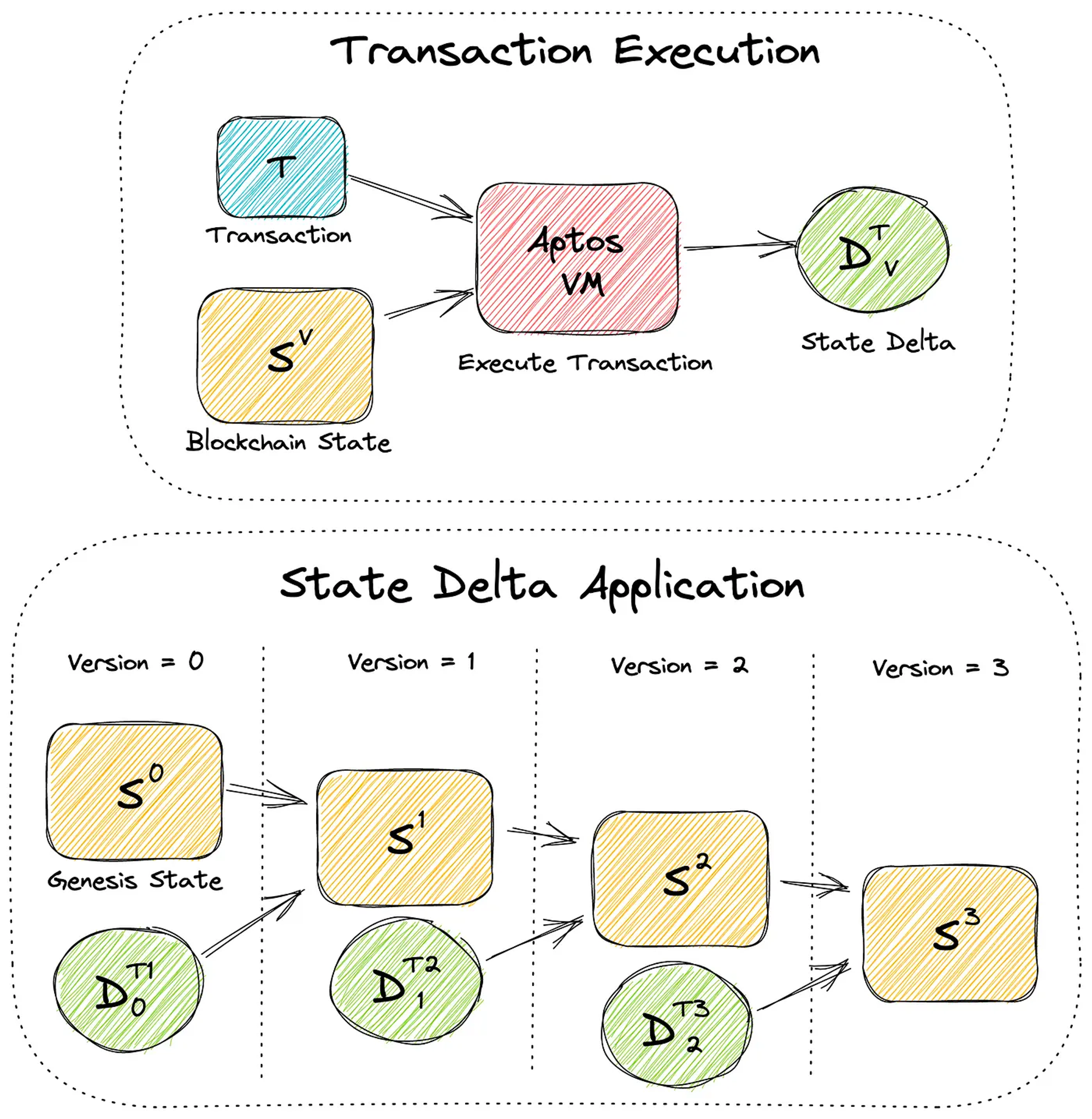
Generally speaking, the core challenges in adopting parallel or concurrent methods are data race issues, read and write conflicts, or data hazard issues. All of these terms describe the same problem: different threads or operations trying to read and modify the same data at the same time. Implementing efficient and reliable parallel systems requires solving complex technical problems, especially in ensuring predictable, conflict-free execution of parallel operations on thousands of decentralized nodes. In addition, the challenge of technical compatibility is to ensure that new parallel processing methods are compatible with existing EVM standards and smart contract code.
For developers, they may need to learn new tools and methods to maximize the benefits of parallel EVM. In addition, users also need to adapt to new interaction modes and performance features that may emerge. This requires participants in the entire ecosystem (including developers, users and service providers) to have a certain understanding of and adaptability to new technologies. At the same time, a strong blockchain ecosystem relies not only on its technical features but also on extensive developer support and rich applications. For new technologies such as parallel EVM to succeed in the market, they need to establish sufficient network effects to attract the participation of developers and users.
Parallel EVM requires efficient network communication to support data synchronization across multiple nodes. Network delays or synchronization failures can lead to inconsistent transaction processing, increasing the complexity of system design. To effectively take advantage of parallel processing, systems need to manage and allocate computing resources more intelligently. This may involve dynamically distributing load across different nodes, as well as optimizing memory and storage usage. Developing smart contracts and applications that support parallel processing is more complex than traditional sequential execution models. Developers need to consider the characteristics and limitations of parallel execution, which can make the coding and debugging process more difficult. In a parallel execution environment, security vulnerabilities may be amplified because a security issue may affect multiple transactions executing in parallel. Therefore, a more rigorous security audit and testing process is required.
Parallel EVM has shown great potential in improving the scalability and efficiency of blockchain. These parallel EVMs mentioned above represent an important shift in blockchain technology and are designed to enhance transaction processing capabilities by executing transactions simultaneously on multiple processors. This approach breaks through traditional sequential transaction processing, allowing for higher throughput and lower latency, which are critical to the scalability and efficiency of blockchain networks.
The successful implementation of parallel EVM relies heavily on the vision and skills of developers, especially in the design of smart contracts and data structures. These elements are critical in determining whether a transaction can be executed in parallel. Developers must consider parallel processing from the beginning of the project and ensure that their designs enable different transactions to run independently without interference.
Parallel EVM also maintains compatibility with the Ethereum ecosystem, which is crucial for developers and users already involved in Ethereum-based applications. This compatibility ensures a smooth transition and integration of existing dApps, which is a challenge for systems like DAG as they often require significant modifications to existing applications.
Developing parallel EVMs is seen as a key step in solving fundamental limitations of blockchain scalability. These innovations are expected to prepare blockchain networks for the future, allowing them to keep up with growing demands and become the cornerstone of the next generation of Web3 infrastructure. While parallel EVMs offer tremendous potential, their successful implementation requires overcoming complex technical challenges and ensuring broad ecosystem adoption.
An overview of the parallel EVM implementation ideas of Ethereum's second-layer Reddio.
 JinseFinance
JinseFinanceMovement Labs, which just received 38 million in financing in April this year.
 JinseFinance
JinseFinanceEVM’s lead is not as large as people think, and it is definitely not “insurmountable”.
 JinseFinance
JinseFinanceThe Parallel Ethereum Virtual Machine (Parallel EVM) is an upgraded version of the traditional Ethereum Virtual Machine (EVM). It improves the blockchain transaction throughput and improves transaction processing speed and efficiency by processing multiple non-conflicting transactions simultaneously.
 JinseFinance
JinseFinanceParadigm led a $225 million financing round for Monad, drawing market attention to “Parallel EVM”.
 JinseFinance
JinseFinanceCan Parallel EVM enable existing decentralized applications to achieve Internet-level performance?
 JinseFinance
JinseFinanceEVM++ aims to open the boundaries of EVM to adapt to the new crypto world
 JinseFinance
JinseFinanceParallel is a strategy card game in which players compete with each other to reduce their opponent's health from 30 to 0 first.
 JinseFinance
JinseFinanceAs the dominant standard for smart contracts, the EVM chain has (to date) the majority of TVL, the largest developer and research network, and an incredible community that has stood the test of time (and multiple bear markets).
 JinseFinance
JinseFinanceSei Network's SEI tokens have surged, benefiting from an increased focus on parallelized EVM and an upcoming network update.
 Kikyo
Kikyo


Please enter the verification code sent to